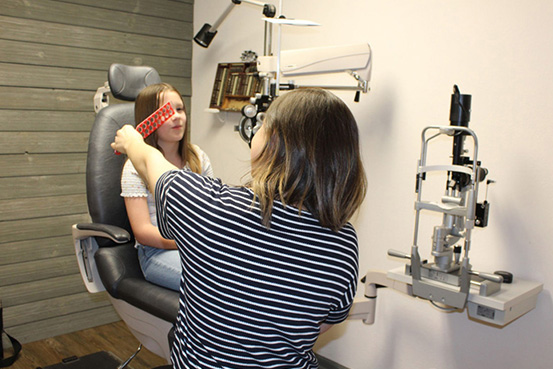Myopia Management in Missouri
When you have trouble seeing, we want to have all the solutions you need, and we’re proud to provide exceptional eye care services to the communities we serve across Mid-Missouri. Nearsightedness is common, especially in children, and to help we offer myopia management — which slows nearsightedness’ progression to keep their eyesight safe for years to come.

What is Myopia Management?
Myopia, also known as nearsightedness, is a common vision condition that causes objects in the distance to look blurry. It also, unfortunately, makes everyday activities and tasks more difficult. Standard glasses and contact lenses can correct eyesight, but they don’t stop the wearer from becoming even more nearsighted over time. And concerns aren’t just about vision they’re also about overall eye health: uncontrolled myopia can lead to serious eye health complications that can permanently affect vision later in life, such as glaucoma, retinal detachment, and myopic maculopathy. That’s why it’s important to treat early!
Why Choose Myopia Management at Missouri Eye Consultants?
We’re here to take care of all your family’s eye care needs — and using state of the art technology, we can detect your child’s myopia right away during our pediatric eye exams. If your child is having trouble seeing at a distance, we’ll be honest about your options and the pros and cons of each, from standard eyewear to preventative myopia management. If we decide together that your child would benefit from myopia control, we’ll craft a personalized treatment plan to keep their nearsightedness in check!

Dr. Jacqueline Byrd, OD
Dr. Byrd, our resident myopia management specialist at Missouri Eye Consultants, loves helping people of all ages tackle their nearsightedness head-on. She’s a compassionate provider who takes the time to explain everything that’s happening — to both parents and children — so they always know the status of their eye health. Dr. Byrd knows it’s important to connect to her patients about their needs and lifestyle: this helps her tailor their myopia control treatment especially to them. While Dr. Byrd oversees myopia managment for the practice, all our doctors are trained to provide myopia management to your child — and love working with kids!
Treatment Options for Myopia Management
Atropine Drops
MiSight Contact Lenses
Testimonials
7 Convenient Locations for Myopia Management
Columbia (Keene St.)
500 N Keene St Suite 103
Columbia, MO 65201
(573) 874-2030
Call usCall Now
Columbia on Nifong
900 W Nifong Blvd Suite 125
Columbia, MO 65203
(573) 874-2030
Call UsCall Now
